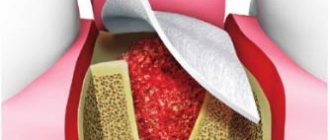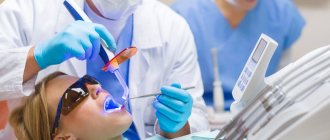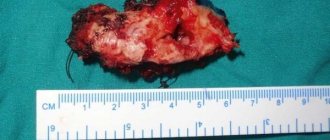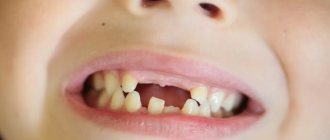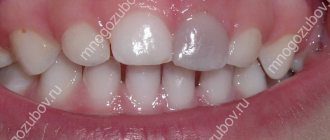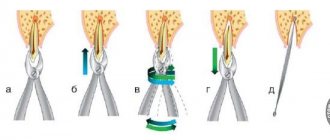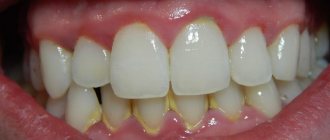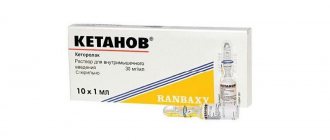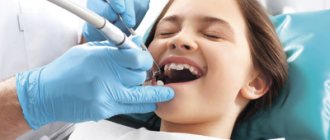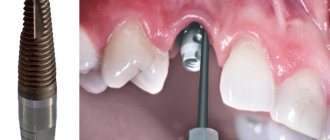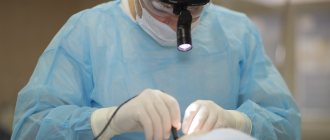- Treatment of caries and pulpitis of milk teeth
- Treatment of caries and pulpitis for children and adolescents under 16 years of age
- Children's prevention and hygiene
- Tooth extraction for children
- Anesthesia for children
If we talk about tooth extraction in children, then first of all we will talk about the removal of milk teeth for dental reasons and during the period of physiological change of teeth to permanent ones.
Permanent teeth have to be removed in children for the same reasons as in adults, and you can read about this in our article on tooth extraction.
How does baby teeth fall out?
The replacement of baby teeth with permanent ones is a physiological process. By the age of 3, a child grows 20 milk teeth in his mouth, which differ in structure from permanent teeth. They have thinner enamel and walls, and more branched roots. Then, gradually, the roots of baby teeth begin to dissolve. At the age of 5-6 years, baby teeth begin to loosen and fall out in the order in which they appeared, and in their place permanent teeth grow from the rudiments. The period of formation of a permanent dentition lasts up to 13-14 years and the appearance of 7 teeth - the second molars - ends. Healthy baby teeth and natural, timely replacement of teeth guarantee the child healthy teeth in his permanent dentition. Therefore, it is best if baby teeth fall out on their own and do not require additional doctor intervention, but this does not always happen.
Recommendations after surgery
- Do not eat or drink water for 6-7 hours after surgery;
- reduce physical activity, avoid visiting saunas and swimming pools for 4-5 weeks to prevent the development of bleeding;
- take analgesics to relieve pain in the early period;
- regularly take antibiotics prescribed for a course of 7 days;
- rinse your mouth with an antiseptic solution after eating;
- follow a gentle diet, avoid solid and irritating foods;
- stop smoking - nicotine provokes bleeding.
Following the doctor's recommendations reduces wound healing time and prevents the development of complications.
Is it possible to remove a baby tooth at home?
The human body is programmed to independently change teeth without complications. If the child does not have dental or general diseases, then the natural loss of a baby tooth is the most desirable scenario. You don't need to do anything to do this. Just when a child’s tooth is loose, pay extra attention to hygiene, because brushing a child’s loose teeth on their own is painful. Make sure that the child does not touch the tooth with his hands - it can cause an infection.
How to help a baby tooth fall out on its own?
The simplest and most effective way is to give your child something hard to chew on, such as an apple. It is better to refuse threads and other fancy devices.
If you decide to help the process a little and remove the interfering tooth yourself, clamp it with a sterile napkin, try to turn it a little around its axis and remove it. Do not “twist” the tooth with force or put pressure on it, so as not to damage the bone and soft tissue. After removal, have your child bite on a sterile cotton swab for 10-15 minutes. There is no need to rinse your mouth after removal; do not feed your child solid food or hot foods for several days.
If you suspect that the tooth has not been completely removed, or the child complains that there is a sharp edge in the hole that “scratches” - contact your dentist as soon as possible.
Removal procedure
With the passage of time and the development of medical technology, the extraction technique has not changed at all. Of course, this is not one of those barbaric methods that were used in ancient times. Today, teeth are removed using forceps. There is simple and surgical removal, the first of which is necessary if the doctor has the opportunity to catch the instrument on the tip of the tooth that remains protruding from the gum.
The second is when the doctor has nothing to take on. Such situations require an integrated approach, in which various deposits on the surface of the teeth are eliminated using ultrasound equipment, then removed, and then antibiotics are prescribed to treat the “wound.”
This procedure no longer causes fear and horror in the eyes of patients. If you trust an experienced professional specialist, you can quickly and comfortably remove a tooth without pain, without hurting other teeth. It is important to always monitor the condition and health of the oral cavity in order to repair, rather than remove, teeth.
Do you need a dental surgeon? Call now
+7
When should a pediatric dentist remove a baby tooth?
There are cases when a baby tooth needs to be removed without waiting for natural loss.
If the tooth is not loose, it CANNOT be removed at home; this can ONLY be done by a pediatric dentist. Temporary teeth have long roots, underneath them there are the rudiments of permanent teeth that can be damaged, and baby teeth themselves are fragile and easy to break. Tooth extraction is a mini-operation, for which you need to contact a specialist.
In what cases does a baby tooth need to be removed?
- The tooth is damaged by 50% or more by caries and cannot be restored.
- Serious complications of caries have led to the fact that the tooth is a source of infection that cannot be cured - periodontitis, periostitis, phlegmon.
- A fistula has formed on the gum next to the tooth.
- A cyst was found on the root of a baby tooth.
- The tooth is injured (severely chipped, twisted by a blow, broken and scratches the mucous membrane)
- The tooth wobbles for a long time, but holds tightly and cannot fall out on its own, which prevents the child from eating.
- The loose tooth became infected and inflammation began.
- A permanent tooth has already erupted next to the milk one, but the milk tooth is not going to fall out.
- If, according to the timing, the baby tooth should have fallen out a long time ago and a permanent one should have grown in its place, but nothing happens. This indicates a delay in root resorption. In order to understand how to proceed, an X-ray diagnosis of the presence of a permanent tooth germ is needed. If there is a germ, then it is better to remove the baby tooth to cause the growth of a permanent one.
- Sometimes a tooth needs to be removed for orthodontic reasons.
Main stages
Regardless of the indications, the tooth is removed in several stages:
- examination by a doctor, diagnostic procedures, medical history;
- anesthesia of nearby areas (carried out by injection into the gum of the anesthetic Ultracaine, Ubestezin, or others)
- ligamentotomy (detachment of the tooth itself from the gum);
- application of forceps, their gradual movement to the area under the gum and further fixation;
- tooth dislocation;
- direct removal of the element from the hole;
- inspection and treatment of the hole using antiseptics and other medications;
- suturing (carried out only if there is a large wound surface).
Usually, tooth extraction goes without problems, but in rare cases, some complications of the procedure itself are possible. This may be a root fracture, bleeding, soft tissue injury and other pathologies that are promptly corrected by a doctor.
If we are talking about removing a wisdom tooth that has not yet erupted but is growing incorrectly, then in this case an incision in the gum is necessary to extract it. In such a situation, the wound is quite deep and the gums take a little longer to heal after tooth extraction.
What anesthesia is used to remove baby teeth in children?
If we are talking about removing a baby tooth that is already loose, without complications and signs of inflammation, then such removal does not require pain relief.
If a problematic baby tooth is removed or it sits firmly in the jaw, then local anesthesia is used for children, sometimes with sedation.
Tooth extraction under anesthesia (general anesthesia) is possible in special clinics where a team of anesthesiologists works. From a medical point of view, in most cases there is no need to remove baby teeth under anesthesia. This is usually due to the fear of the child and his parents. The use of anesthesia is justified only in cases of serious mental disorders or complex illnesses, because it has more dangers than benefits .
Why is it important to adhere to the low-impact principle?
Minimizing trauma to healthy tissues surrounding the tooth is a priority when removing a tooth of any degree of complexity. However, if this procedure is carried out immediately before implantation, then delicate and low-traumatic tooth extraction is necessary not only to protect the patient from unpleasant sensations, but also so that the dentist can reliably fix the implant in the bone tissue.
It is also very important to prepare the patient for the procedure, which, in addition to a comprehensive examination, may include mild sedation to eliminate psycho-emotional discomfort.
Sincerely, Levin D.V., chief physician
What are the dangers of early removal of baby teeth?
If a temporary tooth is forced to be removed before its natural loss by more than a year, then we are talking about early removal. This situation provokes malocclusion and improper development of the entire dental system, including delayed jaw growth.
Neighboring teeth strive to take the place of their distant counterpart, and all of them are displaced.
adjacent teeth and their roots, antagonist teeth also move into the resulting free space. As a result, permanent teeth can erupt chaotically and even outside the dentition. In the future, such a problem will require long-term orthodontic treatment.
In addition, earlier removal of chewing teeth leads to a redistribution of the load on the front teeth, which, in turn, begin to collapse.
Therefore, it is so important to strive to keep all baby teeth in their places for as long as possible, preferably until the time of their natural replacement.
In what cases is simultaneous implantation indicated?
The main indication for simultaneous dental implantation is the loss of one or more teeth, provided that an important condition is met, namely, maintaining the required volume and strength of the jaw bone.
It is recommended to perform one-stage implantation with preliminary tooth extraction when:
- Traumatization, when part of the tooth is damaged and it is not subject to conservative treatment. As a rule, if you consult a dentist in a timely manner after an injury, the bone tissue does not have time to undergo pathological changes and simultaneous implantation is possible with non-traumatic and painless removal of the injured tooth;
- Advanced stages of caries, in which the inflammatory and destructive process does not affect bone tissue. If conservative methods of caries treatment cannot help the patient (most of the tooth crown is destroyed), then it is best to carefully remove the tooth and perform a one-stage implantation;
- The need to restore the dentition as quickly as possible. Single-stage implantation is considered the operation of choice for patients whose professional or social activities require constant contact with people, and therefore require an appropriate appearance. The efficiency of the procedure is the main advantage of one-stage implantation among other methods of dental restoration;
Tooth extraction followed by implant installation is possible only if several important conditions are met. In addition to the absence of atrophic processes in bone tissue, complete sanitation of the oral cavity and the absence of symptoms of inflammatory gum diseases and other dental pathologies are necessary. Therefore, in addition to delicate and low-traumatic tooth extraction before implantation, it is also important to comprehensively prepare the patient for the intervention in order to obtain the desired result from implantation and minimize possible risks.
What to do if a child has a baby tooth removed early?
If trouble happens and the child has one or more milk teeth removed ahead of schedule, it is necessary to take measures to restore the dentition and preserve the space after the extracted teeth.
For this purpose, special dentures are used - removable plates with artificial teeth or special orthodontic structures are installed. In any case, after early removal, you must take the child for a consultation with an orthodontist - he will suggest the right solution. For more information about the treatment of malocclusion problems in children, read: “Children’s orthodontics - correcting the bite in children.”
Price
The cost depends on the technology used:
| Name of service | Price |
| Easy removal | 13,500 rub. |
| Difficult removal | 23,000 rub. |
The case includes:
- anesthesia;
- operation;
- removal and application of sutures.
Additional services:
| Name of service | Price |
| Sedation (per hour) | 12,000 rub. |
| Consultation with existing x-ray examination | 2,000 rub. |
| Consultation and X-ray diagnostics (CT scan in our Center on disk) | 5,200 rub. |
| Sight shot | 500 rub. |
When should a baby tooth not be removed?
There are situations when it is IMPOSSIBLE to remove a baby tooth, so as not to aggravate the child’s condition or provoke serious complications.
- If a child suffers from an acute infectious disease, then removal should be postponed until complete recovery.
- If there is an acute inflammatory process in the oral cavity - stomatitis, gingivitis, candidiasis (thrush), then removal is carried out after the acute stage of the disease subsides.
- If the tooth is located in the area of any tumor, removal is carried out together with the tumor and in the hospital.
- Teeth removal is carried out with caution in small patients suffering from diseases of the central nervous system, heart, kidneys, and blood.
Contraindications for removal
In some situations, urgent tooth extraction without pain is impossible; this procedure must be postponed to a more convenient period. Among them:
- Patient's pregnancy (1st or 3rd trimester);
- The presence of acute forms of various diseases;
- Radiation treatment;
- Diseases with local manifestations (herpes, HIV, fungus, stomatitis, syphilis);
- Mental illnesses;
- Blood diseases;
- Chemical treatment of cancer.
In such situations, it is better to choose the time to remove the tooth from the alveolus more carefully.
What to do after a child’s tooth extraction?
- Make sure that the child spits out the tampon that was placed after removal after 15-20 minutes.
- After removal, a blood clot should remain in the hole, which protects it from inflammation. There is no need to clean the hole from blood, rinse the mouth, the child should not touch the removal site with hands or objects.
- If the child has been given anesthesia, explain to the child that he should not bite on the numb side until the feeling of cold and pins and needles goes away.
- Feed your baby only warm, soft food for several days.
- Maintain good hygiene; brushing your teeth is not only possible, but also necessary, with a soft toothbrush, carefully avoiding the extraction site.
- If the tooth extraction was difficult, then try to limit the child’s physical activity so as not to provoke bleeding.
Painless removal
Many patients are afraid of this treatment method because they understand that the procedure is quite painful. But modern medicine has come far ahead, which makes it possible to remove a tooth without pain. This is facilitated by the selection of effective anesthesia, which reduces sensitivity in the oral cavity and therefore reduces pain. This allows you to quickly and comfortably remove teeth from the alveoli without causing inconvenience to the patient.
To reduce pain the following can be used:
- General anesthesia;
- Local anesthesia.
The first method is needed for situations where it is necessary to remove several roots at once. The second is the most common for removing teeth from the oral cavity and allowing the patient to endure the procedure more calmly. The specialist must first clarify whether the patient is allergic to drugs, and then give the injection professionally. Due to an incorrect injection, pain relief may occur in the wrong area of the mouth or not at all.
Removing a wisdom tooth is more difficult, but in such situations the doctor must choose a more effective painkiller that has a stronger effect. Wisdom teeth cause a lot of discomfort to the owner; they can cause pain or put pressure on adjacent teeth. Therefore, it is also important to eliminate them promptly and quickly.
How to properly prepare a child for tooth extraction in pediatric dentistry?
- A brave child is one who is familiar with the place and situation, so parents need to try to ensure that the first visit to the dental clinic is not associated with treatment, much less tooth extraction and pain. Go with your child to the dental clinic for preventive examinations, children's parties, which we regularly hold, take your child with you when you go to have your teeth treated.
- A good, cozy clinic is not a dream today, but an accessible reality. Go to the clinic yourself without your child, meet the doctor. The atmosphere should be calm, the space should be thought out for small patients. And, of course, no screaming or crying behind office doors.
- Never frighten your child with the dentist or doctors in general, and do not be afraid of them yourself - children subtly sense the mood of their parents.
- Ask your doctor whether it is better to leave your child alone or be present during the procedure. NEVER leave your child alone at the dentist's office if this is their first appointment with the dentist.
- Do not shame your child in the dentist's chair, do not blackmail him with a gift or threaten him with punishment. Introduce him to the doctor and help establish contact between them, using the child’s natural curiosity - he should be interested, not scared.
Laser dental treatment
The latest laser systems have become firmly established in today's medicine; they are also successfully used in dentistry. Laser dental treatment is an opportunity to quickly, and most importantly - without the slightest discomfort and generally without pain, treat caries in the initial stages, treat gum diseases, and carry out whitening and hygiene procedures. The laser has become a real salvation for those people who are afraid to have their teeth treated, because it allows them to undergo treatment without experiencing any fear or pain, even without anesthesia.
A laser beam can be used instead of the notorious dental drill, the mere mention of which may be unpleasant for you - the laser successfully and very carefully removes areas of the tooth affected by caries, while simultaneously disinfecting dental tissues. It is also used instead of a scalpel during implantation, as well as some other dental operations. Unlike a scalpel, the laser beam acts bloodlessly, very accurately and painlessly, while ensuring complete sterility of the surgical field.
Dentist at the 32 Dent clinic Andrey Andreevich Koloskov says: “Our clinic uses the latest laser systems, the work of which many of our patients have already been able to evaluate. Yes, laser dental treatment is more expensive than usual, but for those people who are not too fond of being treated by dentists, it is optimal. Anesthesia is usually not required for this treatment because it does not cause any pain or discomfort.”
How long does it take for a wound to heal?
Normally, the wound surface heals in 4-5 weeks. In older patients, healing is delayed due to decreased tissue repair and reduced blood circulation.
The rate of healing depends on the extent of the procedure and the roots. In the case of complex removal of a molar with 3-4 roots, the process of tissue regeneration is delayed up to 20-25 days.
Restoration of gum tissue goes through the following stages:
- in the first days, the wound is closed by a blood clot (thrombus), formed as a result of stopping the bleeding;
- 3-4 days after removal, the thrombus resolves, and new tissue appears on the surface of the wound in the form of a thin film;
- bone tissue forms on the sides of the socket already at 3 weeks;
- after 3-6 months, the hole heals and has no differences with the jaw bone.
The speed of wound healing after removal depends on the characteristics of the body and the age of the patient. If necessary, the doctor corrects the tissue regeneration process with medications and physiotherapeutic methods.
